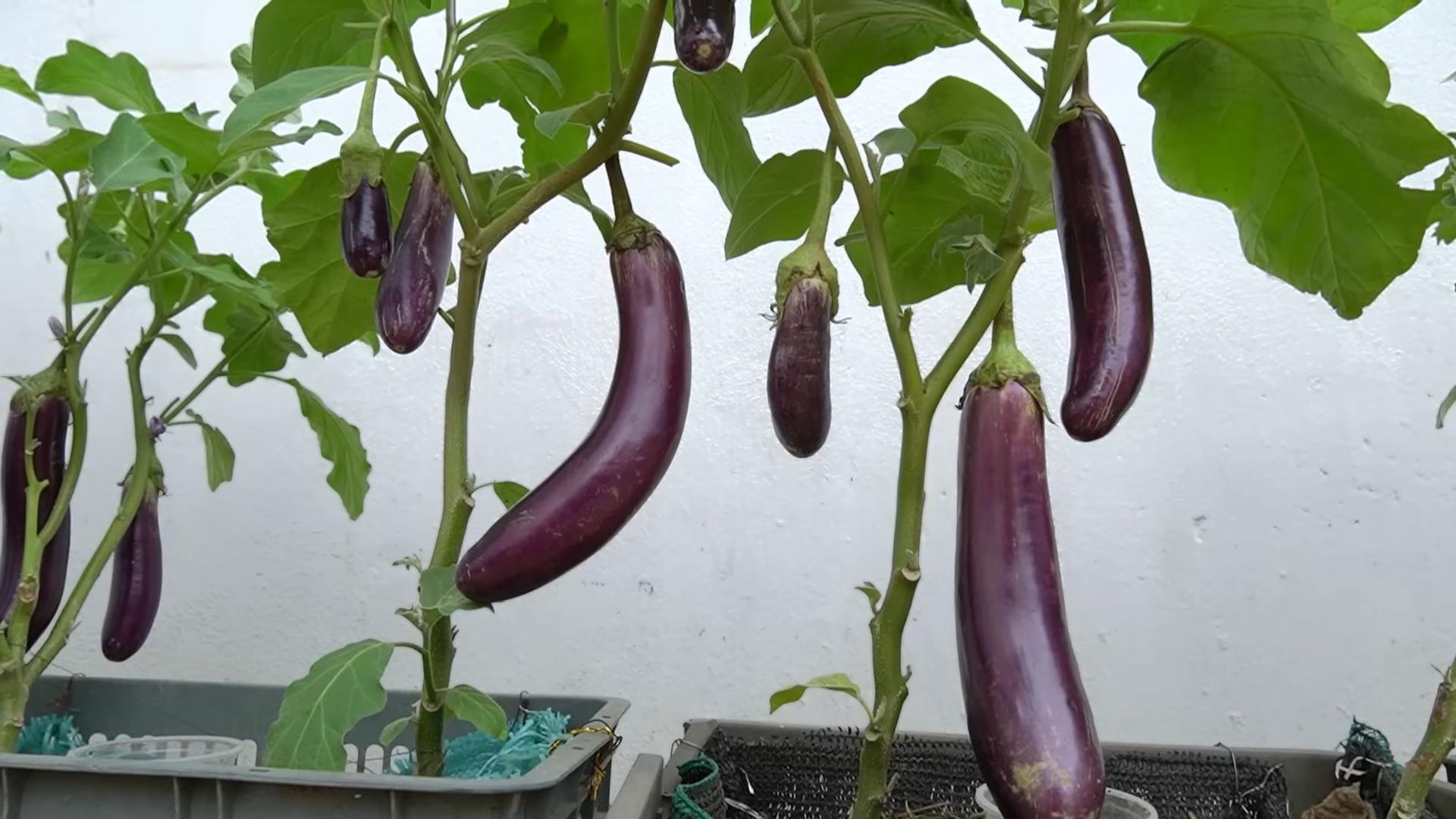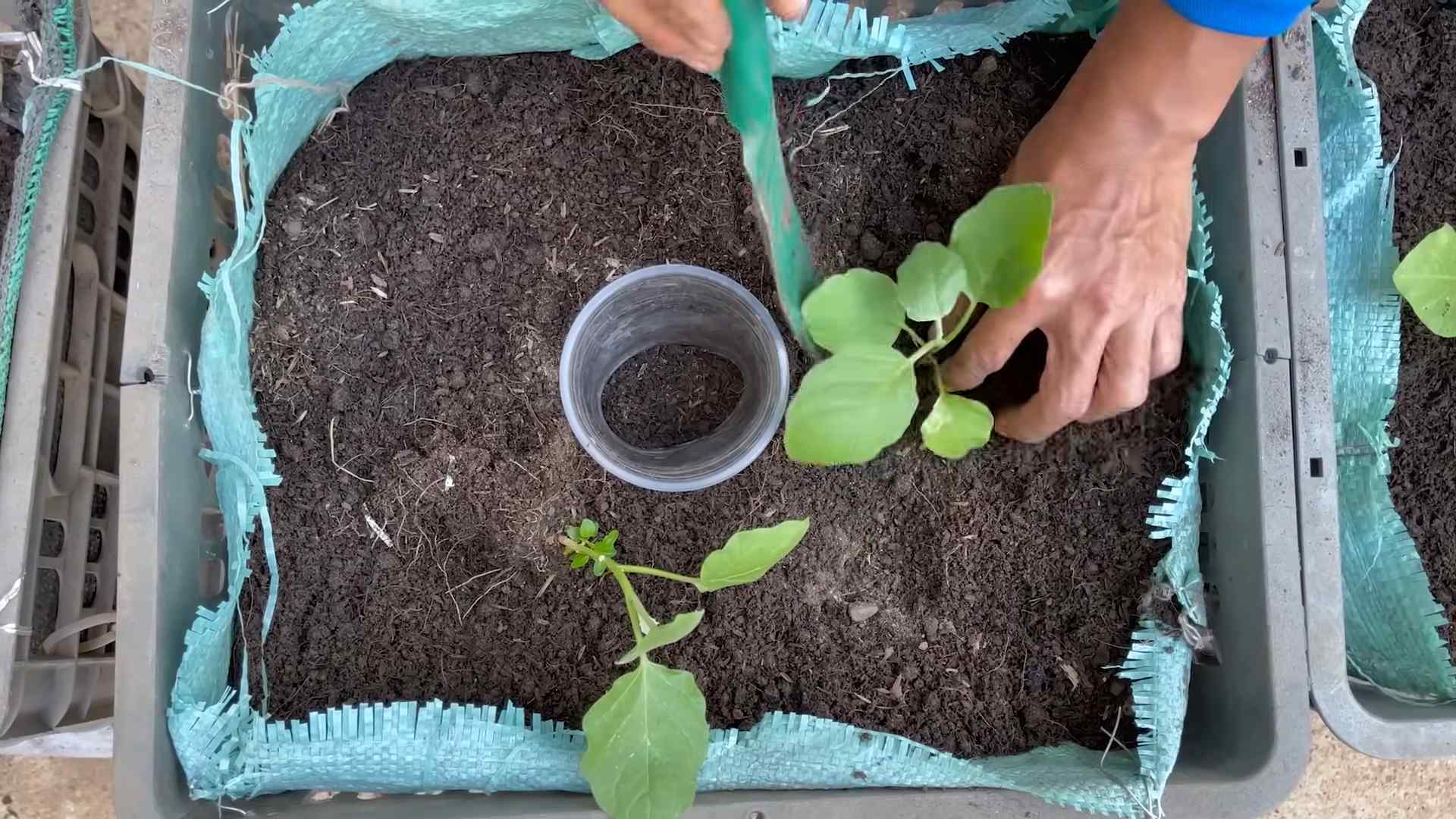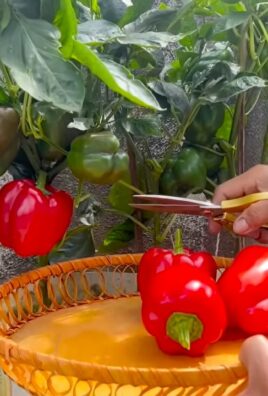Eggplant growing shortcuts – who doesn’t want them? Imagine sinking your teeth into a perfectly grilled eggplant, fresh from your own garden, bursting with flavor. But let’s be honest, growing eggplants can sometimes feel like a slow and arduous process. From battling pests to waiting seemingly forever for those glossy purple beauties to mature, it can test even the most patient gardener.
Eggplants, with their rich history tracing back to ancient India, have been cultivated for centuries, gracing tables across the globe. They’re a staple in Mediterranean cuisine and a beloved ingredient in Asian dishes. But the journey from seed to plate can be a challenge. That’s where these DIY tricks come in!
I’m here to share some of my favorite eggplant growing shortcuts that will help you bypass common pitfalls and accelerate your harvest. We’ll explore simple yet effective hacks to boost growth, protect your plants, and ensure a bountiful yield. Forget spending hours toiling in the garden – these tips are designed to save you time and effort, allowing you to enjoy the fruits (or rather, vegetables!) of your labor sooner. So, grab your gardening gloves, and let’s dive into these game-changing DIY secrets!

Growing Eggplant Like a Pro: My Favorite Time-Saving Hacks
Okay, eggplant lovers, let’s talk about getting those gorgeous, glossy purple fruits on your table faster and easier! I’ve been growing eggplant for years, and I’ve learned a few tricks along the way to maximize my yield and minimize the hassle. Forget waiting forever for those first eggplants – these hacks will get you harvesting sooner than you think.
Starting Strong: Seed Starting Shortcuts
The key to a quick eggplant harvest is giving them a head start. Eggplants are slow growers, so starting them indoors is crucial, especially if you live in a cooler climate. But even starting indoors can be optimized!
* Early Bird Gets the Eggplant: Start your seeds indoors 8-10 weeks before your last expected frost. This gives them plenty of time to develop a strong root system before transplanting.
* Heat is Your Friend: Eggplant seeds need warmth to germinate. Aim for a soil temperature of 80-90°F (27-32°C). A heat mat is your best friend here!
* Individual Cells are Key: Sow seeds in individual cells or small pots. This minimizes root disturbance when transplanting, which can set back eggplant growth.
* Light it Up: Once seedlings emerge, provide them with plenty of light. A grow light is ideal, but a sunny windowsill can work if it gets at least 6 hours of direct sunlight.
* Harden Off Like a Boss: Before transplanting, gradually acclimate your seedlings to outdoor conditions. This process, called hardening off, prevents transplant shock.
Step-by-Step Seed Starting:
1. Gather Your Supplies: You’ll need eggplant seeds, seed starting mix, seed starting trays or small pots, a heat mat (optional but highly recommended), a spray bottle, and a grow light (optional but helpful).
2. Prepare Your Seed Starting Mix: Moisten the seed starting mix with water until it’s damp but not soggy.
3. Sow the Seeds: Fill each cell or pot with the moistened seed starting mix. Sow 2-3 seeds per cell, about ¼ inch deep.
4. Water Gently: Use a spray bottle to gently water the seeds. Avoid overwatering, which can lead to damping off.
5. Provide Warmth: Place the seed starting trays on a heat mat. This will help the seeds germinate faster.
6. Cover and Wait: Cover the trays with a humidity dome or plastic wrap to retain moisture.
7. Monitor and Water: Check the trays daily and water as needed to keep the soil moist.
8. Provide Light: Once the seedlings emerge, remove the humidity dome and place them under a grow light or in a sunny windowsill.
9. Thin the Seedlings: Once the seedlings have their first true leaves (the second set of leaves), thin them to one seedling per cell. Choose the strongest seedling and snip off the others at the soil line.
10. Harden Off: About a week before transplanting, start hardening off the seedlings. Place them outdoors in a sheltered location for a few hours each day, gradually increasing the amount of time they spend outside.
Transplanting Time: Setting the Stage for Success
Transplanting can be a stressful time for eggplants, but these tips will help them settle in quickly and start growing.
* Choose the Right Location: Eggplants need at least 6-8 hours of direct sunlight per day. Choose a location with well-drained soil.
* Amend the Soil: Eggplants are heavy feeders, so amend the soil with plenty of compost or well-rotted manure before transplanting.
* Space Them Out: Space eggplant plants 18-24 inches apart. This allows them plenty of room to grow and prevents overcrowding.
* Water Deeply: Water the plants deeply after transplanting. This helps them establish their roots.
* Mulch, Mulch, Mulch: Apply a layer of mulch around the plants to help retain moisture, suppress weeds, and regulate soil temperature.
Step-by-Step Transplanting:
1. Prepare the Planting Holes: Dig holes that are slightly larger than the root balls of the seedlings.
2. Amend the Soil: Mix compost or well-rotted manure into the soil at the bottom of each hole.
3. Gently Remove the Seedlings: Carefully remove the seedlings from their cells or pots, being careful not to damage the roots.
4. Place the Seedlings in the Holes: Place the seedlings in the holes, making sure the top of the root ball is level with the surrounding soil.
5. Backfill with Soil: Backfill the holes with soil, gently firming it around the seedlings.
6. Water Deeply: Water the plants deeply after transplanting.
7. Mulch: Apply a layer of mulch around the plants.
Feeding Frenzy: Nutrient Boosts for Faster Growth
Eggplants are hungry plants! Regular feeding is essential for maximizing growth and fruit production.
* Start with a Balanced Fertilizer: At transplanting, use a balanced fertilizer (like 10-10-10) to give them a good start.
* Switch to a High-Phosphorus Fertilizer: Once the plants start to flower, switch to a fertilizer that is higher in phosphorus (the middle number). This will encourage fruit development.
* Foliar Feeding: Supplement regular feeding with foliar feeding. This involves spraying the leaves with a diluted fertilizer solution. Eggplants can absorb nutrients through their leaves, which can give them a quick boost.
* Compost Tea: Give your eggplants a boost with compost tea. This is a great way to provide them with beneficial microbes and nutrients.
* Epsom Salts: Epsom salts (magnesium sulfate) can help prevent blossom end rot, a common problem in eggplants. Dissolve 1 tablespoon of Epsom salts in a gallon of water and spray the plants every two weeks.
Step-by-Step Feeding:
1. Choose Your Fertilizer: Select a fertilizer that is appropriate for the stage of growth. Use a balanced fertilizer at transplanting and a high-phosphorus fertilizer once the plants start to flower.
2. Follow the Instructions: Follow the instructions on the fertilizer package carefully. Over-fertilizing can damage the plants.
3. Water Before Fertilizing: Water the plants before fertilizing. This helps prevent fertilizer burn.
4. Apply the Fertilizer: Apply the fertilizer to the soil around the plants, avoiding the leaves.
5. Water Again: Water the plants again after fertilizing.
6. Foliar Feeding: For foliar feeding, dilute the fertilizer solution according to the instructions on the package. Spray the leaves of the plants in the early morning or late evening.
7. Compost Tea: Brew compost tea by steeping compost in water for 24-48 hours. Dilute the compost tea with water before applying it to the plants.
8. Epsom Salts: Dissolve 1 tablespoon of Epsom salts in a gallon of water and spray the plants every two weeks.
Pruning Power: Shaping for Speed
Pruning might seem counterintuitive, but it can actually speed up your eggplant harvest. By removing suckers and unproductive growth, you’re directing the plant’s energy towards fruit production.
* Remove Suckers: Suckers are small shoots that grow from the base of the plant. Remove them regularly to prevent them from draining energy from the main stem.
* Prune Lower Leaves: As the plant grows, prune the lower leaves that are touching the ground. This improves air circulation and reduces the risk of disease.
* Pinch Off Flowers: In the early stages of growth, pinch off some of the flowers. This will encourage the plant to focus on vegetative growth and develop a strong root system.
* Support the Plant: Eggplant fruits can be heavy, so support the plant with stakes or cages to prevent it from falling over.
Step-by-Step Pruning:
1. Identify Suckers: Look for small shoots growing from the base of the plant.
2. Remove Suckers: Use pruning shears or your fingers to remove the suckers.
3. Prune Lower Leaves: Remove the lower leaves that are touching the ground.
4. Pinch Off Flowers: In the early stages of growth, pinch off some of the flowers.
5. Support the Plant: Insert stakes or cages around the plants to provide support.
Pest Patrol: Keeping Problems at Bay
Pests and diseases can slow down eggplant growth and reduce your harvest. Prevention is key!
* Inspect Regularly: Check your plants regularly for signs of pests or diseases. The earlier you catch a problem, the easier it will be to control.
* Use Row Covers: Row covers can protect your

Conclusion
So, there you have it! These eggplant growing shortcuts aren’t just about saving time; they’re about maximizing your yield, minimizing frustration, and ultimately, enjoying the freshest, most delicious eggplants imaginable. We’ve covered everything from seed starting hacks to pest control strategies that won’t break the bank or harm the environment.
Why is this a must-try? Because growing eggplants can be notoriously tricky. They’re heat-loving divas with a penchant for attracting pests and diseases. These shortcuts address those challenges head-on, giving you a fighting chance at a bountiful harvest, even if you’re a beginner gardener. Imagine the satisfaction of serving up a homemade eggplant parmesan, knowing that you nurtured those plump, purple beauties from tiny seeds to culinary masterpieces.
But don’t stop there! Experiment with different varieties of eggplants. Try the Japanese eggplant for its delicate flavor and tender skin, or the Thai eggplant for its unique round shape and slightly bitter taste. Consider companion planting with basil or marigolds to naturally deter pests. You could even try growing your eggplants in containers if you have limited garden space. The possibilities are endless!
And remember, these are just starting points. Every garden is unique, and what works for one person might not work for another. The key is to observe your plants, pay attention to their needs, and adapt your approach accordingly. Don’t be afraid to tweak these shortcuts to suit your specific climate, soil conditions, and personal preferences.
We’re confident that these eggplant growing shortcuts will transform your gardening experience. They’ll empower you to overcome common challenges, unlock the full potential of your eggplant plants, and reap the rewards of a truly satisfying harvest.
Now, it’s your turn! We encourage you to try these tips and tricks in your own garden. Share your experiences with us in the comments below. What worked well for you? What challenges did you encounter? What variations did you try? Your feedback is invaluable, and it will help us refine these techniques and share them with other gardeners. Let’s build a community of eggplant enthusiasts who are passionate about growing their own food and sharing their knowledge with others.
Don’t delay! Get started today and prepare to be amazed by the abundance of fresh, delicious eggplants you’ll be harvesting in no time. Happy gardening!
Frequently Asked Questions (FAQ)
What are the most common problems people face when growing eggplants, and how do these shortcuts address them?
Eggplants are known for being somewhat challenging to grow, and gardeners often encounter several common problems. These include:
* **Slow germination and seedling growth:** Eggplants require warm temperatures to germinate and grow, which can be a challenge in cooler climates. Our seed starting shortcuts, such as using a heat mat and providing adequate light, address this issue by creating optimal conditions for germination and early growth.
* **Pest infestations:** Eggplants are susceptible to various pests, including flea beetles, aphids, and spider mites. Our pest control shortcuts, such as companion planting and using organic insecticides, help to deter pests naturally and minimize the need for harsh chemicals.
* **Disease susceptibility:** Eggplants can be affected by diseases such as blossom-end rot and fungal infections. Our soil preparation and watering shortcuts, such as ensuring proper drainage and avoiding overhead watering, help to prevent these diseases by creating a healthy growing environment.
* **Low yields:** Eggplants require specific growing conditions to produce a bountiful harvest. Our fertilization and pruning shortcuts, such as using a balanced fertilizer and removing suckers, help to maximize yields by promoting healthy growth and fruit production.
Can I use these eggplant growing shortcuts if I live in a colder climate?
Absolutely! While eggplants thrive in warm weather, these shortcuts can be particularly beneficial in colder climates. The key is to adapt them to your specific conditions. For example:
* **Start seeds indoors earlier:** Give your seedlings a head start by starting them indoors 8-10 weeks before the last expected frost.
* **Use a greenhouse or cold frame:** Provide extra protection from the cold by growing your eggplants in a greenhouse or cold frame.
* **Choose early-maturing varieties:** Select eggplant varieties that are known to mature quickly, allowing you to harvest them before the first frost.
* **Use row covers:** Protect your plants from frost and cold temperatures by covering them with row covers.
What are some good companion plants for eggplants, and why?
Companion planting is a great way to naturally deter pests and improve the health of your eggplant plants. Some excellent companion plants for eggplants include:
* **Basil:** Basil repels many common eggplant pests, such as aphids and spider mites. It also attracts beneficial insects that prey on these pests.
* **Marigolds:** Marigolds are known for their ability to repel nematodes, which can damage eggplant roots.
* **Thyme:** Thyme repels cabbage moths, which can damage eggplant leaves.
* **Beans:** Beans fix nitrogen in the soil, which can benefit eggplant growth.
* **Peppers:** Peppers and eggplants belong to the same family and thrive in similar conditions, making them good companions.
How often should I water my eggplants, and how can I tell if they are getting enough water?
Eggplants need consistent watering, especially during hot weather. Water deeply and regularly, aiming for about 1-2 inches of water per week. The best way to tell if your eggplants are getting enough water is to check the soil moisture. The soil should be moist but not soggy. You can also look for signs of underwatering, such as wilting leaves or stunted growth. Avoid overhead watering, as this can promote fungal diseases. Instead, water at the base of the plant.
What type of fertilizer should I use for my eggplants, and how often should I fertilize them?
Eggplants are heavy feeders and benefit from regular fertilization. Use a balanced fertilizer with a ratio of 10-10-10 or 14-14-14. You can also use organic fertilizers such as compost or manure. Fertilize your eggplants every 2-3 weeks, starting when they are about 6 inches tall. Follow the instructions on the fertilizer package for application rates. Avoid over-fertilizing, as this can lead to excessive foliage growth and reduced fruit production.
How do I know when my eggplants are ripe and ready to harvest?
Eggplants are typically ready to harvest when they are firm, glossy, and have reached their mature size. The skin should be smooth and unblemished. Gently press the eggplant with your finger. If it feels firm and slightly resistant, it’s likely ripe. If it feels soft or mushy, it’s overripe. Use a sharp knife or pruning shears to cut the eggplant from the plant, leaving a short stem attached.
What are some common eggplant varieties that are easy to grow for beginners?
Some excellent eggplant varieties for beginner gardeners include:
* **Black Beauty:** A classic eggplant variety with large, dark purple fruits.
* **Ichiban:** A Japanese eggplant variety with long, slender, dark purple fruits.
* **Little Fingers:** A compact eggplant variety with small, finger-like fruits.
* **Rosa Bianca:** An Italian eggplant variety with round, lavender-colored fruits.
These varieties are known for their ease of growth, disease resistance, and delicious flavor.
How can I prevent blossom-end rot in my eggplants?
Blossom-end rot is a common problem in eggplants, caused by a calcium deficiency. To prevent blossom-end rot:
* **Ensure proper soil pH:** Eggplants prefer a soil pH of 6.0-6.8.
* **Add calcium to the soil:** Amend the soil with lime or bone meal before planting.
* **Water consistently:** Avoid fluctuations in soil moisture, as this can interfere with calcium uptake.
* **Mulch around the plants:** Mulch helps to retain moisture and prevent soil from drying out.
* **Use a calcium foliar spray:** If you notice signs of blossom-end rot, spray the plants with a calcium foliar spray.
What if I don’t have a garden? Can I still grow eggplants?
Yes! You can definitely grow eggplants in containers. Choose a large container (at least 5 gallons) with good drainage. Use a high-quality potting mix and follow the same growing tips as you would for garden-grown eggplants. Container-grown eggplants may require more frequent watering and fertilization. Place the container in a sunny location that receives at least 6-8 hours of sunlight per day.





Leave a Comment